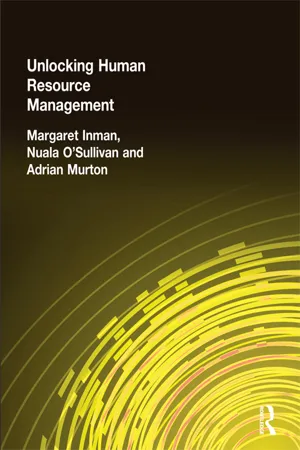![]()
‘Personnel was perceived, to use Drucker’s famous term, as a ‘trash can’ into which all unwanted tasks could be dumped rather than a key element in the search for competitive advantage’
(Guest 1990: 383)
‘HRM represents the discovery of personnel management by Chief Executives’
(Fowler 1987)
CHAPTER OUTLINE
1.1 Managing people is straightforward isn’t it?
1.2 Background
1.3 What is personnel for? (What is special about personnel?)
1.4 The growth of personnel management
1.5 The emergence of HRM
1.6 So what is different about HRM?
1.7 Looking ahead: human resource management in the twenty-first century
1.8 Summary
CHAPTER OBJECTIVES
• Understand the historical origins of personnel management and the ways these have shaped the nature and status of the profession in modern organisations
• Appreciate the ambiguities and contradictions that operate in the personnel/HR role
• Understand the contexts within which HRM emerged and how this is viewed as different from mainstream personnel management
• Appreciate the links between large-scale organisation and the rise of the personnel function
• Understand the various forms of human resource management and their implications for the effective management of people
1.1 | Managing people is straightforward isn’t it? |
It is often assumed that because most people work because they need to – to earn money if nothing else – that they will come in, do their jobs to the best of their ability from the time they enter in the morning to when they leave at night and collect their pay cheques at the end of the week or month. The idea that managing people should present any difficulties or challenges, let alone require a separate department of professionally qualified staff to develop policies to manage them, strikes some people as strange and unnecessary.
Yet, those of you who work and indeed all of us who have experience of work organisations as customers know that things do not always go so smoothly. There are times when people are late for work, ‘throw a sicky’, are asked to do things they don’t want to do or don’t feel is part of their job, argue, get frustrated, bored and angry, and sometimes they leave. Although most of us need to work, what we need and what we want to do as human beings are not always one and the same thing. Also as we will try and show in this and other chapters, what people want from work as workers and what employers want from workers are often different and this can produce tensions which need to be managed carefully, particularly in a world of considerable change.
The aims of this chapter are to explain why the management of people is such a critical issue for organisations, and often more complicated than is realised. It also aims to explain why and how a profession dedicated to managing people came into being and why that profession has changed somewhat from what we used to call ‘personnel management’ to what is now ‘human resource management’. Finally it aims at an assessment of whether this change represents something more fundamental about managing people in the twenty-first century.
People are generally an essential element in any work organisation. From your other studies many of you will be aware that economists often talk about people as a ‘factor of production’ along with land (raw materials and land) and capital (finance, buildings, technology), which are combined together in order to produce an output. This may be physical products such as cars, computers, breakfast cereals, or services like banking, insurance, or sporting events. The essential differences between people and these other factors is that people can think, be creative, have feelings and demonstrate emotion, and may have concerns about how they are treated; fairly, reasonably and with respect at their place of work. This means we need to think particularly carefully about how we manage people and the techniques and policies we may wish to put in place in order to get the best from people at the workplace.
Figure 1.1 People skills are particularly important in the service sector
This is especially true in Britain today when most of us work in the service sector, and where people skills are particularly important in dealing with customers and fellow workers. Those of you who have part- or full-time jobs in organisations such as McDonalds, Pizza Hut, PC World or another high street outlet constantly deal with customers. In doing so you are developing a set of skills seen as highly desirable by potential employers in the long term. It is also the case that in an increasingly competitive world, employers are looking more for continuous improvement and knowledge work which means they are looking not only to recruit but also retain high quality staff required to deliver these elements. It follows that staff, and the people skills that they possess are seen as key elements for organisations in maintaining a competitive edge in the twenty-first century.
However, it was not always this way. Indeed there is a very influential view that despite personnel and HR managers, far from being ‘our most important asset’ people have often been seen as a cost, under-valued and treated as dispensable by those running organisations. It is not our intention to explore this view in detail except to point out that as well as being an asset, people do represent a significant cost for many organisations and if an organisation does experience difficulties in competing in markets, it is likely that they may look to people as a source of savings. What is important here is the balance – and the emphasis placed on each by senior managers.
Of course one person’s wages are another person’s costs and here lies one of the difficulties for managers trying to grapple with people issues in an organisation. The interests of those who own and run organisations and those who work in them clearly overlap. Owners need staff, and individuals generally need to work and both have an interest in an organisation being successful, but there may be differences between them in how this success should be achieved and conflicts over the details of the relationship between them. For example, how much they should be paid, how many hours and how hard they should work, where they should work and for whom? For those with responsibility for managing people these tensions present particular challenges.
1.3 | What is personnel for? (What is special about personnel?) |
Is the role of the personnel or HR manager to support employees, or at least to act as an advocate or ‘champion’ of the employee or is it first and foremost to meet the needs of the business?
In the early days of what came to be called personnel management, it was ‘employee support’ and welfare, often described as the ‘tea and sympathy’ role, which dominated and which helped shape a view of personnel as a necessary but low-key and marginal management function. The origins of what is now the Chartered Institute of Personnel and Development (CIPD), the main professional body for personnel and HR managers in the UK, came with the Welfare Workers Association in 1913, and more formally the Industrial Welfare Workers in 1924. Such origins created their own problems.
The Welfare Workers Association was mainly made up of women whose concerns were primarily to protect women and girls in employment. Although this was important it served to place such work at the margins of organisations. Also for many people, ‘tea and sympathy’ was something that could be done by almost anyone. In a world of heavy industry where manual skills dominated, welfare was seen as ‘patching up’, dealing with the ‘casualties’ of work and organisations and not part of the real business of producing goods and services. Crucially such people skills were seen as secondary to the real tasks of business, and because almost anyone had them, those who had largely failed to perform in other areas of management as in Drucker’s (1961) ‘trash can’ vision, could ‘do personnel’. More controversially, these were skills most closely associated (rightly or wrongly) with women, who at the time were often ‘bit players’ in the world of the industrial economy, a world largely dominated by men.
Although personnel work opened up considerable opportunities for women in management, these were often restricted to clerical positions and the sense that personnel was something that ‘anyone could do’ didn’t help in raising its status within management. Even today, Keith Sisson’s famous description of personnel as the ‘Cinderella function’ continues to cast a long shadow over the way the people management area is viewed by many in organisations (Sisson 1993). The obvious reference to gender is important here but also the question as to whether Cinderella would ever make it to the ball, in organisational terms, whether personnel would ever make it to positions of influence? As Anthony and Crichton have argued ‘The history of the personnel specialists as a group is the history of a struggle for status to become full members of the management team’ (Anthony and Crichton 1969).
Indeed, despite important work by the CIPD, there remains a sense that personnel/HR is still seen by those running organisations as the poor relation to finance, marketing or sales. Forty years on from Anthony and Crichton’s observation there remains the feeling that the personnel and HR profession is one still struggling for identity and influence, a struggle that is partly based on a lack of clarity and conviction about what the basis of its claim to expertise is. Something that has not been helped by the fact that today, most managers are expected to manage people to varying degrees and to demonstrate ‘people skills’.
We will return to this issue later in the chapter, but here we should note that one of the claims made for human resource management is that it is different in important respects from personnel management and this difference marks it out and requires senior managers as well as ourselves, to take it more seriously.
1.4 | The growth of personnel management |
With its origins in the late nineteenth century, welfare workers grew slowly, with around 1300 identified by the end of the First World War. The period between the two world wars in Britain saw the emergence of some very large organisations – ICI, Pilkingtons, Lever Brothers, Marks and Spencer – many of which had grown through merger, and the complexity of these new organisations helped to stimulate growth among what were now seen as labour managers, with an estimated 5300 employed in this area by 1943 (www.cipd.co.uk). Following the end of the Second World War, the number of personnel managers (the Institute of Personnel Management was formed in 1946) continued to grow steadily. This growth accelerated from the mid-1960s as a result of a growing number of large, complex organisations often formed by merger, and by the increasing power and influence of trade unions. Since then, numbers have been further stimulated by the growth of employment legislation since the mid-1970s (see chapter on employm...

